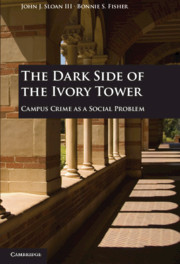Book contents
- Frontmatter
- Contents
- Preface
- Acknowledgments
- The Dark Side of The Ivory Tower
- Chapter One Violence, Vice, and Victimization on American College and University Campuses
- Chapter Two Constructing Campus Crime as a New Social Problem
- Chapter Three Constructing Unsafe and Violent College Campuses
- Chapter Four Constructing the Sexual Victimization of College Women on Campus
- Chapter Five Constructing Postsecondary Institutional Liability for Campus Crime
- Chapter Six Constructing Binge Drinking on College Campuses
- Chapter Seven The Legacy of Claimsmakers
- Index
- References
Chapter Six - Constructing Binge Drinking on College Campuses
Published online by Cambridge University Press: 05 June 2012
- Frontmatter
- Contents
- Preface
- Acknowledgments
- The Dark Side of The Ivory Tower
- Chapter One Violence, Vice, and Victimization on American College and University Campuses
- Chapter Two Constructing Campus Crime as a New Social Problem
- Chapter Three Constructing Unsafe and Violent College Campuses
- Chapter Four Constructing the Sexual Victimization of College Women on Campus
- Chapter Five Constructing Postsecondary Institutional Liability for Campus Crime
- Chapter Six Constructing Binge Drinking on College Campuses
- Chapter Seven The Legacy of Claimsmakers
- Index
- References
Summary
Dude, dude! Wait just a minute here! UCONN should be the undisputed #1 party school in the country!!! On any night of the week (and I do mean any night), you can walk into 10 different wild parties at 10 different spots on or around campus. Don’t forget, Spring Weekend at UCONN is the WILDEST partying on earth. If you’ve never been, let me give you an idea….Thursday night is the first night where Carriage Housing Community packs in 20,000–25,000 people into the streets, the woods, and the houses. Friday night is next at Celeron Housing where the crowd has been increased to around 30,000–35,000 screaming drunken maniacs. Last but not least, Saturday finishes out the weekend in X Lot, a huge parking lot with hundreds of kegs feeding the needs of anywhere from 45,000–50,000 kids with enough alcohol in their systems to kill a team of Clydesdales!
Binge drinking remains higher education’s “dirty little secret.”
The Ivory Tower image of America’s college campuses is severely blurred by alcohol.
For many students entering college, the first few months on campus provide them the opportunity to explore newfound personal freedom. Choices that previously had been made for them by parents and school officials are now theirs to make. As a result, they are free to choose whether to attend class or skip and sleep in. They are also free to choose whether to study in the evening or, instead, play a video game, watch TV, or socialize with friends on various social networking Web sites such as Facebook, MySpace, or Twitter. They can choose to stay up as late as they wish and not have a parent tell them “it’s time for bed” or sleep until noon without a parent telling them “it’s time to get up.” They can explore their own sexuality by dating or “hooking up” with peers. Perhaps most important, students are free to experiment with alcohol or recreational drugs such as marijuana – both of which are readily available on today’s college campuses.
Drinking alcohol is both one of the earliest and most important choices new college students face as they transition into life on campus. According to some observers, both the proportion of students who drink and the amount of alcohol they consume is clear evidence that a core “party culture” – a set of beliefs and customs – exists at many postsecondary institutions. In turn, exposure to the party culture quickly shapes students’ attitudes toward, not to mention their behavior involving, the consumption of alcohol. For example, the collegiate party culture is alleged to approve of drinking not only after class in the evenings and on the weekends but before class as well. The party culture also condones students’ drinking alcohol before, during, and after sporting events, especially football and basketball games, and is actively supported by multimillion-dollar marketing campaigns sponsored by the beer, wine, and distilled spirits industry. In this party culture, drinking plays a pervasive role in routine on- and off-campus social gatherings by students.
- Type
- Chapter
- Information
- The Dark Side of the Ivory TowerCampus Crime as a Social Problem, pp. 139 - 180Publisher: Cambridge University PressPrint publication year: 2010

